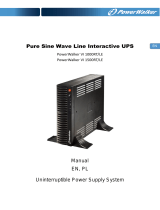
3
stored long-term with the charge level outside the recommended range are recorded and can
be accessed by authorized dealer engineers when troubleshooting or repairing.
5. Charging Exceptions: Exceptions that occur during charging are indicated by the LEDs. Refer to
the LED Patterns section for more details.
6. Auto Balancing: When the battery is in power saving mode for certain length of time, it
automatically balances its cell voltages.
7. Auto Discharging: If the battery remains fully charged for more than 10 days it automatically
discharges to 65% charge.
8. Removable Ports: If the Power Port or Charging and Balancing Port are found to be burned,
corroded, or otherwise damaged they can be replaced by an authorized dealer.
• Refer to the safety requirements on the label afxed to the battery before using the battery.
Users accept full responsibility for any violations of the safety requirements stated on the
label.
• The product warranty expires 6 months after the battery is delivered or after 180 charging/
discharging cycles, whichever is sooner. The product warranty is void if any battery
exceptions occur due to misuse of the battery. (The current number of charging/discharging
cycles can be checked in the mobile device app used when ying the aircraft.)
Using the Battery
Check if the battery rmware version is compatible with the aircraft before using the battery. (Refer
to the aircraft documentation for information about how to check the rmware version compatibility).
If the firmware update fails be sure to retry. Only use the battery once it has been successfully
updated. Refer to the LED Patterns section to see the warning of battery update failure.
Turning the Battery on/off
The battery turns on/off automatically when connected to / disconnected from the aircraft.
• DO NOT allow the battery to come into contact with any kind of liquid. DO NOT leave the
battery near a source of moisture and do not use the battery in humid environments. If
the inside of the battery comes into contact with liquid corrosion may occur, potentially
resulting in the battery catching re, and possibly leading to an explosion.
• Electrolytes in the battery are highly corrosive. If any electrolytes come into contact with
your skin or eyes, immediately wash the affected area with fresh running water for at least
15 minutes, and then see a doctor immediately.
• If the battery falls into water with the aircraft during ight, take it out immediately and put it
in a safe and open area. Never use it again, and dispose of it properly as described in the
Battery Disposal section below.
• Put out any battery re using sand or a dry powder re extinguisher.
• Always use a clean, dry cloth when cleaning the battery terminals otherwise connection
failure may occur.
• DO NOT place the battery on or near wires or other metal objects such as spectacles,
watches, jewelry, and hairpins which could lead to the battery ports becoming short-
circuited.
• Only use officially recommended batteries. Only purchase batteries from authorized
dealers. The manufacturer takes no responsibility for any damaged caused by non-ofcially
recommended batteries.





















